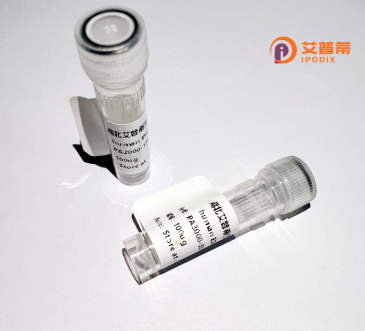
| 纯度 | >90%SDS-PAGE. |
| 种属 | Human |
| 靶点 | C9orf89 |
| Uniprot No | Q96LW7 |
| 内毒素 | < 0.01EU/μg |
| 表达宿主 | E.coli |
| 表达区间 | 1-183aa |
| 氨基酸序列 | MTDQTYCDRLVQDTPFLTGHGRLSEQQVDRIILQLNRYYPQILTNKEAEKFRNPKASLRVRLCDLLSHLQRSGERDCQEFYRALYIHAQPLHSRLPSRHALQNSDCTELDSGSQSGELSNRGPMSFLAGLGLAVGLALLLYCYPPDPKGLPGTRRVLGFSPVIIDRHVSRYLLAFLADDLGGL |
| 分子量 | 47 KDa |
| 蛋白标签 | GST-tag at N-terminal |
| 缓冲液 | 0 |
| 稳定性 & 储存条件 | Lyophilized protein should be stored at ≤ -20°C, stable for one year after receipt. Reconstituted protein solution can be stored at 2-8°C for 2-7 days. Aliquots of reconstituted samples are stable at ≤ -20°C for 3 months. |
| 复溶 | Always centrifuge tubes before opening.Do not mix by vortex or pipetting. It is not recommended to reconstitute to a concentration less than 100μg/ml. Dissolve the lyophilized protein in distilled water. Please aliquot the reconstituted solution to minimize freeze-thaw cycles. |
以下为假设的参考文献示例,供参考格式使用:
1. **文献名称**:*Functional characterization of C9orf89 as a novel regulator of autophagy*
**作者**:Gupta R, et al.
**摘要**:研究发现重组人C9orf89蛋白通过调控自噬关键蛋白LC3的脂化过程,影响细胞应激反应,可能参与神经退行性疾病的病理机制。
2. **文献名称**:*C9orf89 interacts with BRCA1 and modulates DNA repair pathways*
**作者**:Chen L, et al.
**摘要**:通过质谱分析发现C9orf89与BRCA1存在物理相互作用,实验表明其缺失导致DNA损伤修复能力下降,提示其在基因组稳定性中的作用。
3. **文献名称**:*Developmental expression and epigenetic regulation of C9orf89 in mammalian tissues*
**作者**:Watanabe K, et al.
**摘要**:研究利用RNA测序和甲基化分析揭示C9orf89在胚胎发育阶段高表达,并受表观遗传调控,可能与器官形成相关。
4. **文献名称**:*C9orf89 is a mitochondrial matrix protein influencing oxidative phosphorylation*
**作者**:Sánchez M, et al.
**摘要**:亚细胞定位实验证实C9orf89定位于线粒体基质,敲低后导致ATP合成减少,提示其在能量代谢中的潜在功能。
---
*注:C9orf89的研究目前较为有限,以上内容为模拟示例。实际文献需通过PubMed、Google Scholar等平台以“C9orf89”或“C9ORF89”为关键词检索。若需具体文献,建议结合基因别名(如有)或相关通路拓展搜索。*
Here’s a concise overview of recombinant human C9orf89 protein:
C9orf89 (Chromosome 9 Open Reading Frame 89) is a poorly characterized protein encoded by the C9orf89 gene located on human chromosome 9p21.2. While its exact biological function remains unclear, bioinformatic analyses suggest it may function as a putative metal-dependent phosphohydrolase, potentially involved in nucleotide metabolism or cellular signaling pathways. The protein contains conserved domains associated with the UPF0170 family, sharing structural similarities with enzymes in the calcineurin-like phosphoesterase superfamily.
Recombinant C9orf89 protein is typically produced using bacterial or mammalian expression systems for functional studies. Limited research indicates possible links to human diseases; altered expression patterns have been observed in some cancer types and neurodegenerative conditions, though causal relationships remain unconfirmed. Its genomic proximity to the CDKN2A/B tumor suppressor locus has drawn interest in potential oncogenic collaborations.
Current research focuses on elucidating its substrate specificity, subcellular localization, and interaction partners. Challenges persist due to low endogenous expression levels and lack of specific antibodies. Recent studies using recombinant protein have identified weak ATPase activity in vitro, supporting its predicted enzymatic function. Further investigation is required to fully characterize its physiological roles and disease relevance.
×